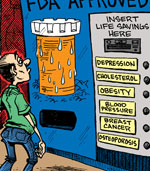Five Things You Need to Know about Fast - Acting Vitamin E For Nutritional Support Inside and Out
| Share on Facebook | Share on Twitter | Share on Google+ |
These are the forms of vitamin E found in food. They are ready to go to work as soon as they are absorbed from the digestive tract into the bloodstream. But the problem with these fast-acting forms of vitamin E is that they sometimes begin their work even before they enter the bloodstream.
These potent, natural antioxidants sometimes spend all their free radical fighting power dealing with conditions in the bottle, not the bloodstream. To prevent degradation of these forms of vitamin E in supplements, manufacturers make vitamin E esters.
An ester is a chemical combination of an alcohol and an acid. A vitamin E ester is a chemical combination of a vitamin E alcohol, such as alpha-tocopherol, with a naturally occurring acid, such as acetic acid.
Acetic acid, as you know, is the acid found in vinegar. Combining alpha-tocopherol and acetate from acetic acid creates alpha-tocopheryl acetate, one of 32 ester forms of vitamin E that are far more stable for long-term storage.
Acetic acid is just one of a four naturally occurring, organic acids commonly used to make vitamin E esters. When manufacturers use acetic acid, they create vitamin E acetates. If they use succinic acid, the resulting products are vitamin E succinates.
There are also vitamin E linoleates, made by combining one of the eight forms of vitamin E alcohols with linoleic acid, and vitamin E nicotinates, made by combining vitamin E with nicotinic acid. But vitamin E acetates and vitamin E succinates are by far the most common forms of vitamin E.
Stability is the objective behind the making of vitamin E acetates.
When a vitamin E acetate is sealed in a capsule and the capsule is stored in the jar flushed with nitrogen, the supplement stays fresh and ready for use for years-until you open the jar!
Most of the time, however, that jar of the best quality vitamin E capsules (not the kind you buy in a discount store) will contain vitamin E succinate, not vitamin E acetate. And there's a good reason. Vitamin E acetates go to work faster in the body, but vitamin E succinates build up reserves faster in the liver.
Also, vitamin E succinate is a nice, white powder that can be mixed with other nutrients to make multivitamins. Vitamin E acetate isn't as "friendly" to other ingredients in a multivitamin capsule. Is all of this just a little confusing?
Here are the five things you really need to know about the different forms of vitamin E.
- The alcohol forms of vitamin E all have chemical names that end in -ol. They are very fast acting, but they are also very difficult to store on the shelf. That is why they are esterified to make chemicals with names that end in -ate, such as the transformation of d-alpha-tocopherol to d-alpha-tocopheryl acetate. The -ate form of vitamin E is stable in pills, capsules, and lotions.
- The acetate form of vitamin E acts quickly because it's easier for the liver to break down into the alcohol (-ol) or active form of the vitamin. Any chemically modified form of vitamin E, by the way, only works for you if you have good liver function.
- The succinate form of vitamin E is easier to mix with other vitamins. It is a little harder for the esterases (enzymes) in the liver and the rest of the body to break down into its original, active form, but it's also easier for the body to store.
- The linoleate and nicotinate forms of vitamin E are chemically ideal for direct application to the skin. Vitamin E linoleate is a great skin moisturizer. And, finally,
- Milligram for milligram, your body releases more active vitamin E from vitamin E acetate than from any of the other chemically modified forms of the vitamin. And you get more active vitamin E from a natural, d- form of vitamin E than from a synthetic, dl- form of vitamin E. This means that d-alpha-tocopheryl acetate, the natural form of vitamin E that is chemically treated to make it shelf-stable is about 20 per cent more available to your body than dl-alpha-tocopheryl acetate, which combines vitamin E with "other stuff" that is made in a cheap manufacturing process.
More Vitamin E Related Articles
Benefits of Vitamin E - Facts About Vitamin E. What are the health benefits of vitamin E?
Vitamin E and Pregnancy - What is the role of vitamin E for pregnancy problems?
Vitamin E Benefits for Men - What are the health benefits of vitamin E for men?
Vitamin E and Diabetes - What is the relation between vitamin E and diabetes?
Vitamin E and Heart Disease - What are the benefits of vitamin E in heart disease?
Vitamin E and Hot Flashes - What is the role of vitamin E for hot flashes?
Vitamin E Benefits for Women - What are the benefits of vitamin E for a woman’s health?
Vitamin E Foods - What are the best sources of foods rich in vitamin e?
Vitamin E for Hair - Does vitamin E help hair growth? What does vitamin E do for your hair?
Vitamin E for Scars - Is vitamin E really good for acne scars?
Vitamin E for Skin - What are the benefits of vitamin E on skin?
Vitamin E Overdose - Can you overdose on vitamin E? How much vitamin E should i take?
Vitamin E for Stretch Marks - For most women, pregnancy is a joyful time. Stretch marks, however, can become a nagging problem that vitamin E can help.
Vitamin E Oil Benefits - What are the health benefits of vitamin E for hair, face and scars?
Vitamin E Side Effects - Can you take too much vitamin E? What are the side effects of using too much vitamin E?
Vitamin E Supplements - How to choose best vitamin E supplement for your health condition?
Vitamin E and Cancer - Is vitamin E effective in cancer prevention and treatment?
Vitamin E Succinate - What is Vitamin E Succinate?
Vitamin E Oil - Vitamin E is one of the most popular cosmeceuticals for rejuvenating wrinkled skin. It is the most important ingredient in wrinkle creams specifically formulated for dark skin.How does vitamin E help skin?
Vitamin E and Selenium - What is the role of vitamin E and selenium in fighting cancer.
Vitamin E and Fertility - Learn how vitamin E can be beneficial in fertility treatment.
Vitamin E Deficiency - What are the health risks of a vitamin E deficiency?
Vitamin E Dosage - How much vitamin E should i take daily?
Vitamin E For Wrinkles - Vitamin E is one of the most popular cosmeceuticals for rejuvenating wrinkled skin. It is the most important ingredient in wrinkle creams specifically formulated for dark skin.
-
Skin CareMen Skin Care
-
Free ResourcesFree eBooks
-
To think is to practice brain chemistry.Deepak Chopra
-
Featured Health Supplement
 If you find a product that is as effective as Total Balance, and is better value for money, let us know and we will give you a refund equivalent to your entire purchases of Total Balance…retrospective.
If you find a product that is as effective as Total Balance, and is better value for money, let us know and we will give you a refund equivalent to your entire purchases of Total Balance…retrospective.
-



















